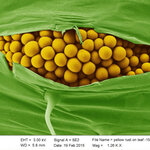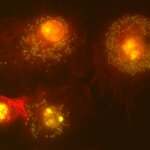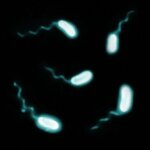Microbiology

By: Charles Q. Choi, Inside Science
(Inside Science) -- Viruses that invaded the DNA of humanity's ancestors millions of years ago may now play critical roles in the earliest stages of human development, researchers say.
The discovery sheds light on the key part that viruses may have played in human evolution, scientists added.
The early stages of embryonic development lay the foundation of what become the organs and tissues of an organism. Past research had revealed that a host of factors can influence early human development, such as the diets and environments of parents. Now researchers…

Wheat is a critical staple crop that provides 20% of the calories and over 25% of the protein consumed by humans.
'Yellow rust' caused by the fungus Puccinia striiformis f. sp. tritici (PST) is one of the plant's major diseases and is found throughout the major wheat-producing areas of the world. Infections lead to significant reductions in both grain quality and yield, with some rare events leading to the loss of an entire crop. New strains of the fungus have recently emerged that adapt to warmer temperatures.
They are more aggressive and have overcome many of the major defensive genes in…

Oats are often touted for lowering bad cholesterol, improving the immune system, lowering blood pressure and, more recently, being gluten-free, but a new study finds that some oat-based breakfast cereals in the U.S. contain a mold-related toxin called ochratoxin A (OTA) that's been linked to kidney cancer in animal studies.
Natural or not, they may need closer monitoring for potential mold contamination, warns a paper in the Journal of Agricultural and Food Chemistry.
Dojin Ryu and Hyun Jung Lee note that
ochratoxin A
is one of the most common toxic products…

A new genetic therapeutic technique that has the potential to treat more than half of the patients suffering from Duchenne Muscular Dystrophy (DMD), according to a new study.
DMD is caused by problems with the body's ability to produce dystrophin, a long-chain protein that binds the interior of a muscle fiber to its surrounding support structure. Dystrophin is coded by a gene with 79 genetic "chunks" called exons. If any one exon gets a debilitating mutation, the chain does not get built. Without dystrophin providing support, muscle tends to shred and slowly deteriorate.
The disease…

Just about everyone
in the developed world
has taken an antibiotic to treat a bacterial infection and the instructions are well-known; don't stop after you start to feel better, even though you know they are killing machines.
Yet the picture may be more complex, according to a new paper, and it might change our understanding of why bacteria produce antibiotics in the first place.
"For a long time we've thought that bacteria make antibiotics for the same reasons that we love them - because they kill other bacteria," said Elizabeth Shank, an assistant professor of biology at…

Would you like some Campylobacter
or E. Coli today? Raw milk in 26 U.S. states is now the best place to get it, since most readers of Science 2.0 are not going to have the opportunity to buy chicken from a street vendor in China.
That raw milk is risky and has no benefit is not news. In 2012 the CDC showed it again but clamoring for raw milk got even louder. It is in the news again, as part of the naturalistic fallacy that infects mostly the anti-science hippie left and a minority of people on the libertarian 'government can't regulate what diseases I should give my children' right…
“Nothing in biology makes sense except in the light of evolution.”
T. Dolzhansy (Russian Geneticist)
“We admit that we are like apes, but we seldom realize that we are apes.”
Richard Dawkins
Evolution teaches us that humans and chimpanzees are “…

We have beneficial bacteria because of symbiosis: the success of the host determines the survival and spread of the microbe. But if bacteria grow too much they may become deadly. In a new study, a research team from Instituto Gulbenkian de Ciencia found that a single genomic change can turn beneficial bacteria into pathogenic bacteria, by boosting bacterial density inside the host.
Ewa Chrostek and Luis Teixeira studied the symbiosis between a fruit fly (Drosophila melanogaster) and the bacterium Wolbachia to answer how benign bacteria become pathogenic. Wolbachia is present in most insect…

Every summer, there are reports linking a bacterium called Vibrio vulnificus to people getting sick or dying. The bacteria are found in warm saltwater and problems occur after eating raw tainted shellfish or when an open wound comes in contact with seawater.
People with a weakened immune system, chronic liver disease or iron overload disease are most at risk for severe illness. Vibrio vulnificus infections in high-risk individuals are fatal 50 percent of the time.
Now, researchers at UCLA have figured out why those with iron overload disease are so vulnerable. People with the common genetic…

Understanding microbial activity in rhizosphere -- the critical zone where plant roots, microbes and minerals interface -- is critical to promoting plant health. Pacific Northwest National Laboratory, CC BY-NC
By Elizabeth Bent, University of Guelph
People are increasingly aware of the link between the trillions of microbes that live within our bodies and human health. Studies have found that a healthy population of bacteria, or a microbiome, in a person can prevent food allergies and even treat depression.
Just as in the human body, these types of tiny bugs can play an beneficial role in…